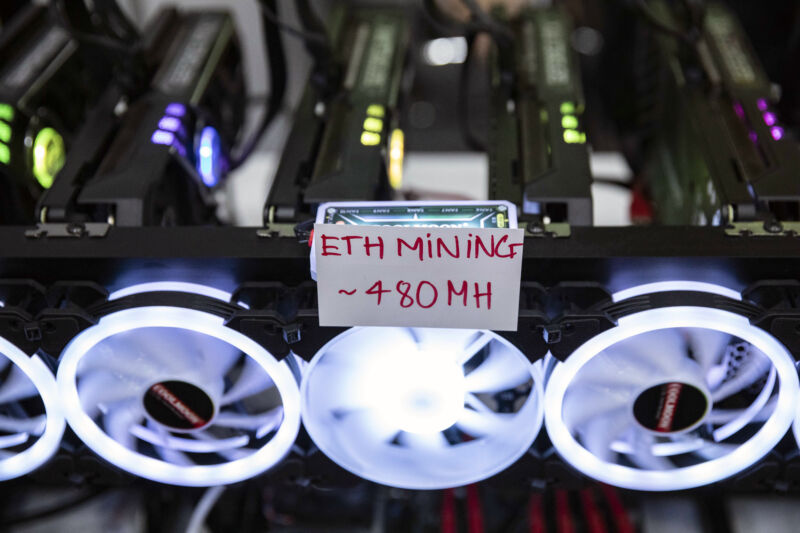
Andre Malerba/Bloomberg via Getty Images
In a few weeks, Ethereum is slated to undergo the most significant change in its seven-year history. Until now, the Ethereum blockchain has been secured using a method called “proof-of-work,” which consumes more electricity than the entire nation of Belgium. Next month’s switch to a new method called “proof-of-stake” is expected to cut Ethereum’s energy consumption by a factor of 1,000.
The stakes are high. A botched transition could mean chaos for the many crypto projects built on top of Ethereum. A smooth transition would be the culmination of years of careful planning by Ethereum’s core developers. Over the last year, developers have repeatedly pushed back the date of “the Merge” to give themselves more time to prepare. They completed a final dress rehearsal on August 10, clearing the way to make the switch in mid-September.
The most immediate consequence of a successful Merge will be to put the world’s Ethereum miners out of work. Over the last seven years, thousands of people have bought high-end graphics cards to help maintain the Ethereum blockchain—and to earn newly created ether in the process. The new system for updating the Ethereum blockchain doesn’t require the same kind of beefy hardware—or the massive electricity bill that goes with it. So the price of used graphics cards might continue to fall as Ethereum miners exit the industry.
But the switch to proof-of-stake is much more than just an energy-saving measure—it’s a major overhaul of the Ethereum network. Ethereum founder Vitalik Buterin believes the Merge will lay the foundation for a series of future upgrades that will allow the network to handle a much larger volume of transactions in the coming years. But critics worry that the new scheme could cause the Ethereum network to become overly centralized—and hence vulnerable to government regulation.
From proof-of-work to proof-of-stake
At a high level of abstraction, here’s how any blockchain works: Someone on the network proposes a block containing a list of recent transactions. Then other network participants verify that the block follows the network’s rules. If a sufficient number of other network participants accept the block, it becomes the “official” next block in the chain. As long as most network participants are honest, users can have confidence that transactions accepted by a majority of the network won’t be removed or modified later.
The big challenge for any blockchain project is preventing a malicious party from creating many sock puppet accounts to “stuff the ballot box,” outvote the honest participants and thereby tamper with past transactions. Bitcoin’s pseudonymous founder Satoshi Nakamoto’s big insight—the one that made bitcoin possible—was that this problem could be solved using the principle of “one hash, one vote.” On the bitcoin network, whoever has the most computing power—specifically, the capacity to compute SHA-256 hashes—has the most influence over which blocks get added to the blockchain. As long as honest miners have more hash power than malicious miners, users can be confident in the integrity of the blockchain—and hence in the integrity of payments made using the bitcoin network. (Check out our in-depth bitcoin explainer for details on how this works.)
When Vitalik Buterin launched Ethereum in 2015, he used a variant of Nakamoto’s scheme. By that point, bitcoin mining was already dominated by specialized silicon optimized for computing huge numbers of SHA-256 hashes, locking ordinary bitcoiners out of the mining game. So Buterin developed a new mining algorithm designed to be “memory-hard”—and therefore difficult to accelerate with custom hardware. As a result, Ethereum mining is still largely performed using off-the-shelf graphics cards, allowing ordinary Ethereum users to participate.
But the economics of the two networks are fundamentally similar. As the values of bitcoin and ether have risen, it has become profitable for people to spend more and more money on mining hardware—and electricity—to generate new coins. While this has made the networks more secure, it has also meant that both networks consume astronomical amounts of electricity and hence drive more and more carbon emissions.
The bitcoin and Ethereum communities have responded to this issue very differently. Satoshi Nakamoto disappeared from public view in 2011. In his absence, bitcoin’s culture has become increasingly conservative. Many bitcoiners adamantly oppose changing bitcoin’s mining system, fearing that changes could open the door to centralization and ultimate government control. As a result, bitcoin is unlikely to move away from proof-of-work in the foreseeable future.








